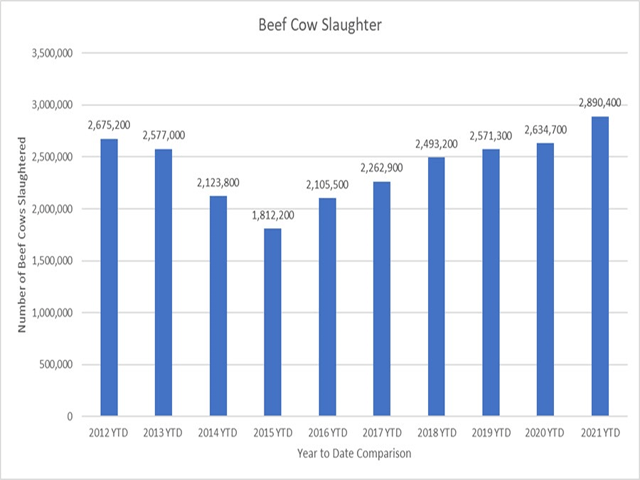Call the Market
The Cycle of Drought, Cowherd Liquidation and Higher Feeder Cattle Prices
When it comes to business, there are very few pursuits that are as challenging as those that involve the cattle market. Feed prices fluctuate, labor is nearly impossible to come by, input costs are always on the rise and no matter how good you get at understanding the markets, there's always one wild card that will keep even the best producers humble -- and that's drought.
This year was supposed to be a rebounding year for the cattle market, but with the onset of severe drought conditions throughout the West, and even in parts of the Midwest, producers have continued to be challenged. Cow-calf producers in the West have been liquidating their cowherds by drastic measures; in the years to come, the liquidation of these cows will be undeniably evident in the cattle market.
The problem with drought is that its rotten presence lasts far beyond what most realize. When thinking about destocking due to drought conditions, producers need to be cautious of both visible and invisible costs. Visible costs are the easy costs to point out; if a producer is contemplating destocking due to drought conditions, a visible cost would be knowing that in the near future he/she would have to buy back some replacement quality females.
It's the invisible costs that often outweigh and outnumber the visible costs -- making them far more dangerous. Invisible costs could be having fewer calves to sell when the market reaches its peak, higher interest rates and unaccounted-for inflation.
P[L1] D[0x0] M[300x250] OOP[F] ADUNIT[] T[]
The easiest way to understand the ramification of visible and invisible costs is to remember the drought of 2012 and the cattle market thereafter. In 2012, cattlemen in the South faced a backbreaking drought that nearly crippled the southern markets. Cattlemen spent hours upon hours on the phone, looking for leases to send their cows to and calling hay producers as far North as Montana and North Dakota to secure whatever feed they could get their hands on. The drought eventually subsided as rain fell and business went on as usual, but the cattle market was about to go for a wild ride.
By the fall of 2013 and throughout all of 2014, the feeder cattle market rallied to prices that the market had never seen before. By the end of 2014, 750- to 800-pound feeder cattle were demanding prices above $2.20 per pound and buyers were willing to take anything they could get their hands on. At the same time, the corn market fell from trading over $7.00 per bushel in 2013 down to $4.00 per bushel by December of 2014. Cow-calf producers were beaming with joy as their margins had exceeded their wildest beliefs, and everyone -- from the town doctor to the weatherman -- wanted to be in the cow business.
This is where my fear for the years ahead and Northern cow-calf producers lies. It's one thing to manage drought conditions and to fluctuate cow numbers to cash-flow amid high hay prices and limited grass, but it's utterly painful to miss out on high calf prices when the market's cycle deems that high prices are in store for producers.
It would be reckless to project exactly where feeder cattle prices are going to be in 2022, 2023 and even 2024 without knowing definitively how significant this market's liquidation cycle has been on the U.S. cowherd. However, upon analyzing the number of beef cows that have been processed this year, we will undoubtedly see a vast reduction in the January 2022 Cattle Inventory report. The chart that accompanies this column helps explain my point. In 2021, through the week of Oct. 23, there have been 2,890,400 head of beef cows processed; that's 215,200 head more than what had been processed in 2012 through the same timeframe. With a smaller cowherd producing fewer calves than what the industry has grown accustomed to, and with beef demand being exceptionally strong, feeder cattle prices should rally as feedlots have to compete more aggressively with one another to secure the number of calves they need to fill their lots.
When drought conditions cripple a region, producers must weigh the costs of finding supplemental grass, buying more hay and/or shipping their cows out of state for management where drought conditions aren't present -- none of which are easy decisions. With the cattle cycle where it is, producers also need to realize that feeder cattle prices are likely bound to rally in the near future, and without having cows to produce those calves, it's hard to capitalize on the market's rally, and the rally rarely lasts for long.
**
Plan on attending the DTN Ag Summit, Dec. 5-7 in Chicago, to get an inside look at what the various markets anticipate for 2022. I will be presenting the Livestock Outlook on what to watch for in the year ahead. Visit www.dtn.com/agsummit for more details about the summit and to register. Register before Nov. 26 for the early bird rate.
ShayLe Stewart can be reached at ShayLe.Stewart@dtn.com
(c) Copyright 2021 DTN, LLC. All rights reserved.




